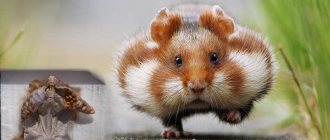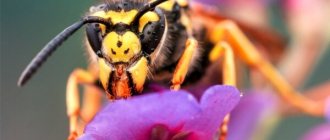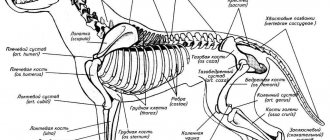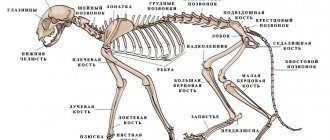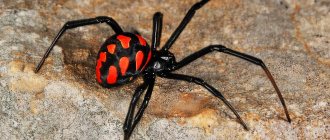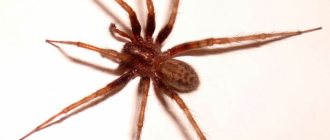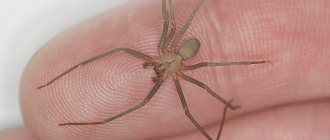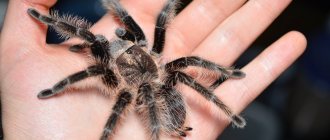Spiders are one of the oldest animals on Earth and can be found almost everywhere in the world today. It is difficult to be indifferent to these creatures: they frighten some, fascinate others.
These are amazing creatures of nature that still hide many mysteries.
Is a spider an insect or not?
Many people wonder whether a spider actually is an insect or an animal. Most will immediately answer that it is an insect, but this is not the case. Even if in appearance this organism looks like crawling small inhabitants, it is in no way related to them and has distinctive features.
They are animals; among the inhabitants of the fauna they are classified as invertebrates. These are arthropods that have jointed limbs, a hard chitinous cover, which is a hard exoskeleton.
Therefore, the question arises why spiders are not insects and animals. And also interested in what exactly connects mammals, what common features they have with insects and differences from them. This is worth considering carefully.
General signs
The family of spiders and insects share some common characteristics. This is due to the fact that arachnids belong to the class of arthropods.
Nutrition
As mentioned above, the main dish of spiders is insects. But the eating process itself is of greater interest, because digestion occurs outside the intestines. The meal can take from 1 to 3 hours.
By piercing the caught prey with chelicerae, the spider injects digestive juice into it in portions, which is produced by the labial glands and liver. It dissolves all soft tissue, leaving hair, bones and chitinous cover. These same chelicerae cause damage, as a result of which the ready-to-use “cocktail” comes out. Like the movements of a cat's tongue, the spider eats it with the help of the muscular rostrum, and then repeats the actions, turning the victim on the other side.
Interesting facts about spiders
Unusual facts about spiders will amaze many who do not yet know about these creatures. But they conceal many mysteries, secrets, and have unique features that other organisms living on the globe do not have.
Let's look at 15 interesting facts about spiders:
- The web is not only a trap for insects, it is capable of deflecting several millimeters in order to grab and stick an insect to itself. This phenomenon is carried out due to a static charge, which appears during the flight of the insect.
- The bite of the Brazilian wandering spider is not always fatal, but it often causes impotence in men.
- With the help of its limbs, the spider can determine what has reached it in the web. But edible or inedible helps him establish the olfactory organs, which are located on his legs.
- The animal has a durable shell. Its strength can withstand a nuclear explosion.
- The web is very light. If you take a spider thread the length of the earth's equator, then its weight will be only 340 grams.
- Spider web is considered a powerful and durable material. If its thickness is increased to the thickness of a pencil, then such a web could stop a Boeing. In New Guinea, fishermen use this material to catch fish, and in South America there are spider web bridges that support monkeys.
- The lifespan of arthropods is 30 years. But they rarely die of old age.
- At one time, the female can lay up to 20 thousand eggs, from which spiders hatch.
- In nature, there are varieties of spiders that, after being born, eat their mother.
- There are varieties of arachnids in which the brain occupies the largest part of the body, so other organs are forced to be located on the legs. The smaller the spider, the larger its brain.
- In the Netherlands there are more spiders than people. For 15 million human population there are 5 thousand billion arthropods.
- In Cambodia, people enjoy eating tarantula spiders. They are also brought up at home, they learn to dance, and play willingly. And if necessary, they can protect the owner.
- There are types of spiders that do not weave webs - the jumping spider, the lynx spider. They do not catch prey with webs, but hunt it.
- Tarantulas can live without food for about two years.
- The gladiator got its name due to the fact that it weaves a web in a square. He does not leave her until the prey falls into her; he himself abruptly throws the net on her, thereby leaving no chance to escape.
Meaning in nature
The role of arachnids in nature is great. The poison of various species is capable of neutralizing insects that are carriers of dangerous and fatal diseases. Some representatives feed on plant remains and help improve soil quality.
In their nets, individuals catch many pests that destroy crops. Small spiders are a source of food for reptiles. Many species take part in soil formation.
Today, a large number of arthropods are listed in the Red Book and are on the verge of extinction (for example, the smiling spider).
Interesting Facts
Spiders inspire fear in people, but at the same time they inspire interest. Therefore, they are studied and even raised at home as pets.
Flying spiders There is evidence that some species of spiders can fly. And this is not to instill fear in the impressionable. This method is a protection and a method of movement.
Spiders with a tail There were individuals that had a tail. Unusual tailed spiders and their descendants.
Spider web Spider web is a durable and stable material; it can stretch many times and return to its original position.
Man and Spider
Spiders play a fairly significant role in people's lives:
- arthropods destroy many harmful insects, helping to preserve the yield of agricultural plants;
- in some countries, well-cooked spiders of some species are considered a delicacy;
- scientists are actively studying the properties of spider venom and exploring the possibilities of using it in medicine to treat various diseases, for example, Alzheimer's disease or erectile dysfunction;
- some species are very popular as exotic pets;
- physicists are studying the unique properties of the web and its role in the life of spiders and are trying to create a similar material.
In addition, the unusual appearance and abilities of arthropods have become the reason that spiders often become characters in works of art: comics, books, films.
But the danger of spiders to humans is greatly exaggerated. Indeed, the bite of some poisonous individuals can cause health problems, but very often the person himself provokes an attack. It is extremely rare for spiders to attack people for no reason.
Arachnophobia
Arachnophobia, or fear of spiders, is one of the most common and difficult to treat phobias in the world. People with this disease experience attacks of fear and sometimes panic at the sight of even the smallest and most harmless spider.
Moreover, not only a living person, but also his image can cause negative emotions. Attacks are often accompanied by weakness, dizziness, nausea and increased sweating. Particularly sensitive people faint.
Fun fact: Most patients have never experienced an arachnid attack, so their fears are unfounded.
Myth 2. Wherever you are, there is a spider a meter away from you
Image: Egor Kamelev / Unsplash
Another popular internet horror story that terrifies arachnophobes. Allegedly, statistics know for sure that spiders are everywhere in the world. And one meter away from you - well, or a foot, three feet or six feet - it’s as if a furry eight-legged killing machine is sitting and ominously rubbing its chelicerae. And then how he jumps!
This myth apparently originated with Myth: You are never more than three feet from a spider / The Burke Museum in 1995 due to the words of arachnologist Norman Platnik, who wrote in one article: “Wherever you sit reading these lines, at least one spider will probably be no more than a few yards away from you.”
There are, of course, a lot of spiders in the world - science now knows Types of Spiders & Spider Facts / Live Science 40,000 species of these arthropods. However, we have only discovered about 10%, and they live on all continents except Antarctica. It’s just not at all necessary that at least one is near you right now.
Of course, if you're sitting on the lawn, there are probably spiders in the grass. But in winter, of course, they won’t be there. Likewise, in an office in a high-rise building, spiders will be much more rare guests than in a country house.
No one has ever Myth: You are never more than three feet from a spider / The Burke Museum done the calculation to find out how far away the average spider is from the average person. And Norman Platnik just pulled a number out of thin air to add an effective phrase.
Features of reproduction
During the process of active growth, spiders from time to time shed their tight shell, which consists of a chitinous structure. They gradually acquire a new, stronger one.
Over the entire period of their life, they can molt up to 10 times . Spiders are heterosexual individuals, with the female being much larger than the male.
The mating period lasts quite a long time, its season begins in mid-autumn and lasts until early spring. At this time, the male fills the bulbs, which are located at the ends of the pedipalps, with sperm, then he goes in search of the female.
After performing the “mating dance” and fertilization, the male leaves and dies in the subsequent period.
As soon as 2.5 months have passed, the female lays eggs. After 35 days, spiderlings hatch from them and live in the web until the first molt. Sexual maturity in females occurs at the age of 3-5 years.
Internal structure.
Spiders feed on liquid tissues sucked from their victims, mainly insects. The digestive system of spiders consists of a specialized sucking stomach, another stomach with blind outgrowths, and an intestine surrounded by a digestive gland (“liver”) and opening at the end of the body with an anus.
The circulatory system is not closed. It consists of the heart, arteries, veins and spaces (sinuses) between organs, washed by colorless blood (hemolymph). The heart is a pulsating tube with holes (ostia) that runs along the dorsal side of the body cavity. Unlike insects, it is not divided into several chambers.
Spiders, as already mentioned, breathe air. Their respiratory organs are the trachea and lungs, called pulmonary books. Each such book consists of a bag, one of the walls of which is folded in the form of numerous leaf-shaped folds, reminiscent of pages. They exchange oxygen and carbon dioxide between the blood and the air. The lungs open to the outside with spiracles. The most primitive spiders have two pairs of pulmonary books; in more advanced ones, one or both of them are replaced by trachea piercing the body.
The excretory system consists of a pair of coxal glands in the cephalothorax and the so-called. Malpighian vessels in the abdomen, which open into the intestine.
The nervous system is similar to that of insects. It consists of an abdominal trunk with branches extending to different organs and ganglia collected in the cephalothorax into a large subpharyngeal node, above which is the suprapharyngeal node - the “brain”. Sensory hairs are located on the pedipalps and walking legs.
The reproductive organs are represented by ovaries in females and testes in males. Their openings are located below at the base of the abdomen.
Insects and spiders
These two types of arthropods are often confused. But they have much more differences than they have in common. Among insects, there are those that eat meat and those that are vegetarians. Spiders are mostly predators.
Spiders are definitely not insects! More differences in the structure and behavior of insects and spiders in the article at the link.
Spider Anatomy
Spider eyes The number of eyes is not an indicator of good vision. And spiders are a prime example of this.
Spider legsThe limbs perform not only a walking role. They help in hunting.
Spider reproductionThe method of reproduction of spiders is determined by their lifestyle and structural features.
Range, habitats
These animals live everywhere, with the exception of Antarctica and other regions covered with ice all year round. They are also absent on some remote islands, where they simply could not reach. Most species inhabit equatorial regions and the tropics, in particular tropical rainforests.
They settle in burrows underground, in cracks on tree trunks, in the thick of branches and foliage. They can live in any cracks and crevices, often settling under stones. Many of the species of spiders have chosen people's homes as their habitat, where they feel quite comfortable.
Among the predominant number of terrestrial species, only the silver spider and some spiders that hunt on the surface of the water chose the water element as their habitat.
Return to content
Is a spider an insect or not? Why is a spider not an insect?
Spiders, especially small ones, are similar in appearance to insects, but are not insects. But why is a spider not an insect?
Insects and arachnids are divided into two different classes, which belong to the same phylum of animals - arthropods. They have some similarities in structure, but there are many more differences. Family connections are revealed by the chitinous cover and some details of the body structure: the chest and abdomen are connected by a thin stalk, legs are located in pairs on the sides of the chest. Only an insect has six legs, and a spider has eight. In addition, the spider has chelicerae - small limbs with poisonous claws located next to the mouthparts.
The front part of the body is also different: in insects the movable head is separated from the chest; in arachnids there is not even any semblance of a “neck”; the head is combined with the chest into one part of the body, which is called the cephalothorax.
Black widow (Latrodectus mactans)
Insects have two eyes with a complex structure, spiders have much more primitive eyes, but there are eight of them. There are spiders with six eyes and rarely with two.
Insects are carnivores and vegetarians. The former eat their food with powerful jaws and literally chew their food; the latter mainly feed on nectar using “proboscis”. The feeding of spiders is radically different - they inject gastric juice into their prey, wait until the soft tissues soften and then suck up the nutritious “soup” through a narrow mouth slit, devoid of teeth, lips and, in general, any signs of the oral apparatus familiar to us. Almost all spiders are predators; only one species has been found that feeds on plants - Kipling's bagheera spider.
The head of all types of insects is decorated with a pair of antennae; spiders do not have these antennae.
Another striking difference is the web. Spiders have three pairs of arachnoid warts that release a thin stream of sticky liquid, which hardens after a few seconds without losing its stickiness. A spider's web is a trap for insects that do not know how to create such deadly laces.
By the way, the spider is much more closely related than insects to scorpions and mites, which also belong to the class of arachnids.
Arachnophobia is a special case of zoophobia, fear of arthropods (mainly arachnids), and is one of the most common phobias. Moreover, for some people, it is not even the spider itself that can cause much greater fear, but the image of the spider.
Safe
The word “safe” means that their bite has not yet caused death. However, it can be painful, cause allergic reactions and be accompanied by swelling, since most spiders still contain poison, although not very toxic.
For people suffering from arachnophobia, their appearance is especially dangerous. Thus, the tarantula grows up to 27 cm in length, has an eerie palette and thick hair, but despite this, exotic lovers see it as an excellent pet.
House spider
From the name it is clear that this species lives near people - in gardens, rotten trees, houses, apartments, warehouses and other premises. Its size is 1-2 cm, and its color is different shades of brown. Rarely does anyone manage to see a web, since it is only several times larger than the individual and is located in dark, secluded places.
This representative feeds on insects and, thanks to its powerful paws, often catches them with lightning-fast attacks. For them, a poisonous bite is fatal, but a person will only feel pain for a couple of hours, so it is absolutely safe. There is a sign that the spider settles in the apartment where peace, tranquility and love reign, so it is only scary in appearance.
South Russian tarantula (mizgir)
It lives in deserts, forest-steppe zones and in places where there is little moisture, and lives most of the time in its burrow. Representatives can grow up to 3 cm, and in appearance and structure they are similar to other tarantulas. The diet consists of insects, but if there is a shortage of food, it may include larger targets - frogs, mice, and other spiders.
Mizgir is also considered safe for people and pets, however, its poison does not cause the most pleasant sensations. The bite site may hurt for 1 to 3 days, while it swells and turns yellow for several months. Often the victim's temperature rises and vomits.
Horse
The dimensions of the jumping spider often do not exceed 10 mm. According to the description, this is a small, nimble spider that can be found anywhere. Due to its tiny body, it eats exclusively insects, and avoids humans even if protected, since it is unable to bite through the skin. “Horses” received this nickname due to their powerful jumps of up to 20 cm.
Their limbs have a special structure and can expand or contract simultaneously with the pressure inside the body. The 8 eyes located around their heads help them calculate the trajectory and distance to the target, and jumps are always made with a safety thread. They can be of different colors - white, blue, yellow, black, because the family has about 5,000 species.
Additional Information! There is a flower spider that belongs to the sidewalker family. You can find it in the flower of some plant, and it got its name for its incredible ability to move sideways.
Argiope Brünnich garden
Despite such a complex name, everyone has seen this spider, because it has a specific color on its back and is somewhat reminiscent of a wasp. This representative belongs to the orb weaver breed, so it is often found sitting on a large round web with its limbs arranged in the shape of the letter X.
Argiope's list of enemies includes everything that falls into the web, even the human hand. There have already been similar cases, but since its poison is weak, no deaths have been recorded. The reproduction of these representatives is much more interesting. Immediately after mating, the female eats the male, and she dies as soon as she lays eggs in cocoons. Thus, the offspring obviously remain without parents and develop independently.
